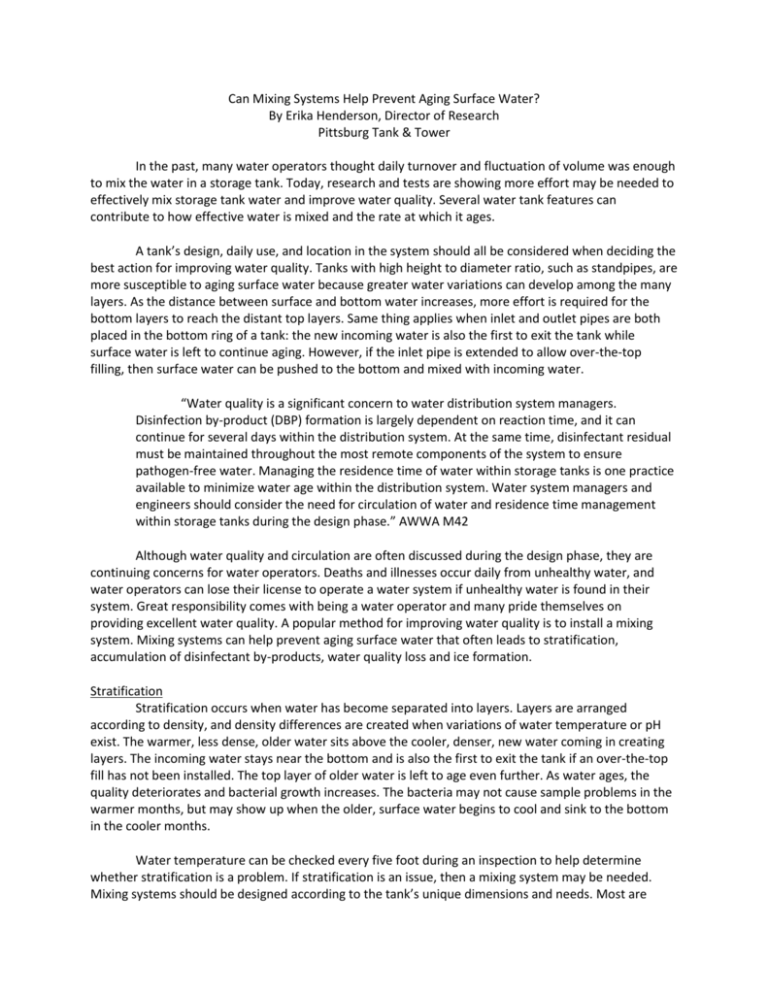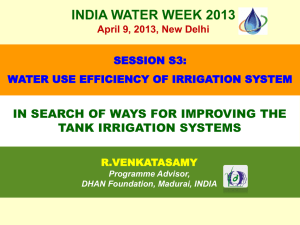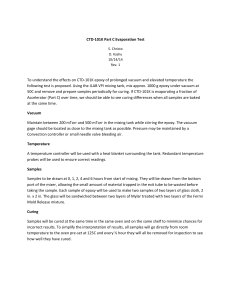FEA2 Can Mixing Systems Help Prevent Aging Surface Water
advertisement

Can Mixing Systems Help Prevent Aging Surface Water? By Erika Henderson, Director of Research Pittsburg Tank & Tower In the past, many water operators thought daily turnover and fluctuation of volume was enough to mix the water in a storage tank. Today, research and tests are showing more effort may be needed to effectively mix storage tank water and improve water quality. Several water tank features can contribute to how effective water is mixed and the rate at which it ages. A tank’s design, daily use, and location in the system should all be considered when deciding the best action for improving water quality. Tanks with high height to diameter ratio, such as standpipes, are more susceptible to aging surface water because greater water variations can develop among the many layers. As the distance between surface and bottom water increases, more effort is required for the bottom layers to reach the distant top layers. Same thing applies when inlet and outlet pipes are both placed in the bottom ring of a tank: the new incoming water is also the first to exit the tank while surface water is left to continue aging. However, if the inlet pipe is extended to allow over-the-top filling, then surface water can be pushed to the bottom and mixed with incoming water. “Water quality is a significant concern to water distribution system managers. Disinfection by-product (DBP) formation is largely dependent on reaction time, and it can continue for several days within the distribution system. At the same time, disinfectant residual must be maintained throughout the most remote components of the system to ensure pathogen-free water. Managing the residence time of water within storage tanks is one practice available to minimize water age within the distribution system. Water system managers and engineers should consider the need for circulation of water and residence time management within storage tanks during the design phase.” AWWA M42 Although water quality and circulation are often discussed during the design phase, they are continuing concerns for water operators. Deaths and illnesses occur daily from unhealthy water, and water operators can lose their license to operate a water system if unhealthy water is found in their system. Great responsibility comes with being a water operator and many pride themselves on providing excellent water quality. A popular method for improving water quality is to install a mixing system. Mixing systems can help prevent aging surface water that often leads to stratification, accumulation of disinfectant by-products, water quality loss and ice formation. Stratification Stratification occurs when water has become separated into layers. Layers are arranged according to density, and density differences are created when variations of water temperature or pH exist. The warmer, less dense, older water sits above the cooler, denser, new water coming in creating layers. The incoming water stays near the bottom and is also the first to exit the tank if an over-the-top fill has not been installed. The top layer of older water is left to age even further. As water ages, the quality deteriorates and bacterial growth increases. The bacteria may not cause sample problems in the warmer months, but may show up when the older, surface water begins to cool and sink to the bottom in the cooler months. Water temperature can be checked every five foot during an inspection to help determine whether stratification is a problem. If stratification is an issue, then a mixing system may be needed. Mixing systems should be designed according to the tank’s unique dimensions and needs. Most are designed to take the denser, newer water from the bottom and mix it with the less dense, warmer surface water. Mixing helps maintain consistent water temperatures and pH levels throughout the tank thus preventing stratification. However, mixing must occur regularly to prevent reoccurring stratification, sample inconsistences and inaccurate disinfection treatment. Disinfectant By-Products Disinfectant decay occurs when chemicals used for disinfection react with other organic material, organisms, and surfaces. These reactions create carcinogenic disinfectant by-products known as Trihalomethanes (THMs) and Halo-acetic acids (HAAs). By-products are present in almost all chlorinated water supplies, but the key is keeping these levels as low as possible. Mixing systems can help keep these levels low by effectively blending all water with disinfectants to ensure that no zone within the tank experiences an extended contact time. When disinfectant contact time is balanced through proper mixing, less chlorine concentration is needed and thus fewer by-products are produced. Ice Formation Most compounds become denser as they change from a liquid to a solid because the molecules become more tightly packed. But water is most dense at 39.2°F (4° C), and becomes less dense at lower temperatures causing ice to float. Water in a tank is the same and according to NFPA 25, “the temperature of water tanks shall not be less than 40°F (4.4°C).” When temperatures fall below freezing, ice can form on the surface. The ice will continue to expand and get thicker as the water temperature remains below freezing. Ice can cause serious damage to a tank: tank coatings are often damaged, pipes can become clogged, leaks and structural damage can result, and even tank failures have occurred from ice forming in water tanks. “When a tank freezes, one or more of the following conditions usually results and cause leakage. Inside overflow or other piping breaks occur. Ladders or other attachments to the container are pulled out by ice, making a hole at the point of attachment. Ice pressure can expand and place hoop stress loads on the steel and seams, which may cause the tank wall to yield or burst. Leaks due to corrosion become apparent.” AWWA M42 Mixing systems can provide regular water circulation to help maintain a consistent water temperature above freezing and prevent the water from separating into layers where dangerous ice can form on the surface and sides of tanks. Maintaining Water Quality All tanks should be regularly monitored for mixing efficiency, but tanks with low filling cycles, high volume, or at the end of a water system should be monitored more often. These types of tanks may not only require mixing system upgrades, but may also require more frequent inspections and cleanings to maintain water quality and reduce aging surface water. Mixing systems can help prevent aging surface water, but they must be designed and installed properly to be effective. A reputable tank company with knowledge and experience in these types of upgrades should be contacted to perform the work. It is important to coordinate with your state water regulatory agency to determine if there are specific construction regulations or guidelines for the installation of tank mixing systems and whether a permit is required. For further information on water tanks and mixing systems please contact Don Johnston at 270-748-1343 or djohnston@watertank.com References American Water Works Association, 2013. Steel Water Storage Tanks. Manual M42 Revised Edition, Chapter 5, Water Quality Issues. American Water Works Association, 2013. Steel Water Storage Tanks. Manual M42 Revised Edition, Chapter 10, Results of Freezing. National Fire Protection Association, 2011. Standard for the Inspection, Testing, and Maintenance of Water-Based Fire Protection Systems. NFPA 25 2011 Edition, Section 9.2.4.1.







